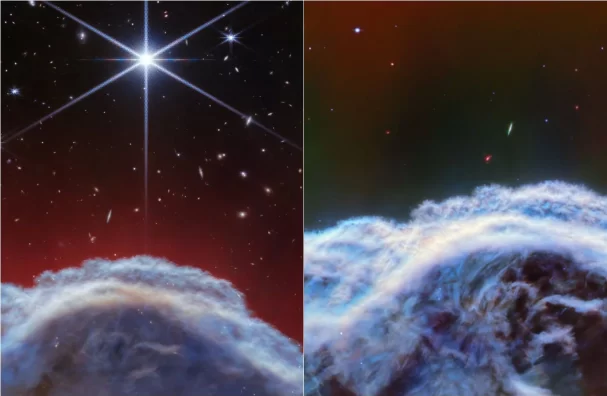
The Horsehead Nebula, a small dark nebula in the constellation Orion, is recognized for its distinctive equine shape and its role as a stellar nursery. This term refers to regions in space where new stars are born, attributing significant astronomical importance to the Horsehead Nebula.
Scottish astronomer Williamina Fleming was the first to discover the Horsehead Nebula in 1888. Since then, it has been a favorite subject among both amateur and professional astronomers and has been featured in countless astronomy books for over a century.
The James Webb Space Telescope’s (JWST) image of the Horsehead Nebula is the most detailed to date. The captured image focuses on a part of the nebula known as the horse’s “mane,” which spans about 0.8 light-years and is approximately 1,300 light-years away from Earth.
Horsehead Nebula: Yeigh or Neigh? 🐴
The Horsehead Nebula is famously known for…looking like a horse’s head. Webb captured the top of the "horse's mane," giving us the sharpest infrared images of the region to date: https://t.co/2SDdbAOkYM pic.twitter.com/0zWxukU4EA
— NASA Webb Telescope (@NASAWebb) April 29, 2024
According to the European Space Agency (ESA), JWST’s observations capture the nebula’s complexity with “unprecedented spatial resolution.”
The JWST, equipped with its MIRI (mid-infrared instrument) and NIRCam (near-infrared camera) instruments, has unveiled small-scale structures within the nebula. The image highlights blue-colored clouds and red-colored wisps along the nebula’s illuminated edge, which were previously invisible.
The blue clouds contain a mix of hydrogen, methane, and water ice, while the red wisps represent atomic and molecular hydrogen. The image also captures a warm region of gas and dust, created by ultraviolet light from nearby young, massive stars.
In 2023, the ESA’s Euclid telescope captured an image of the nebula in just one hour, revealing previously unseen Jupiter-mass planets in their early stages. Prior to that, the Hubble Space Telescope, in honor of its 23rd anniversary in 2013, released an image of the nebula in infrared, revealing its delicate structure usually obscured by dust.
Given its role as a stellar nursery, the Horsehead Nebula will likely continue to be a focus for astronomers. The nebula is a birthplace for planets, young brown dwarfs, and baby stars, and scientists such as Euclid legacy scientist Eduardo Martin Guerrero de Escalante express particular interest in this region due to its unique star formation conditions.
